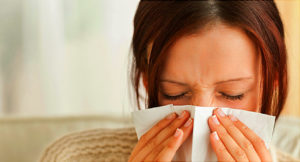 From everydayhealth.com
From everydayhealth.com
Indoor allergens such as dust mites, pet dander, mold, and cockroach droppings can trigger allergy and asthma symptoms in millions of allergy sufferers. In fact, a survey published in the Journal of Allergy and Clinical Immunology found that at least six allergens were detectable in more than than 50 percent of homes. Carried in through the air, allergens can be found on furniture, floors, and other surfaces around the house. While no home can be completely allergen-free, thorough cleaning on a regular basis can help reduce the number of allergens to which you’re exposed. Try these 10 tips for minimizing indoor allergens, and breathe easier from now on.
Follow Dusting Dos and Don’ts
One of the best ways to control indoor allergens is by getting rid of dust. That’s because dust mites, the most common trigger of asthma and allergy symptoms inside the home, thrive in dust. But be aware that dusting can actually make things worse by kicking up allergen particles into the air. Use a damp or treated cloth that attracts dust rather than scattering it, and consider wearing a dust mask when cleaning. Also, try to minimize clutter in your home, since it tends to collect dust.
Vacuum to Reduce Allergens
Vacuuming, especially in areas that accumulate more dust, such as carpeting and furniture, can help control allergens in your home. But as with dusting, vacuuming can also send dust particles into the air and cause problems for anyone with a dust mite allergy. Use a vacuum with a HEPA filter, which can trap small particles and prevent them from spreading into the air. Try to vacuum at least once or twice a week.
Wash Away Allergens
Dust mites tend to thrive in bedding, pillows, and throw rugs. And since we spend so much of our time in the bedroom, it’s especially important to reduce allergens there. At least once a week, wash pillowcases, sheets, and blankets in very hot water — at least 130 degrees — and dry them in a hot dryer to kill dust mites. Also, encase mattresses and non-washable pillows, comforters, and other bedding in allergen-proof covers.
Use Green Cleaning Products
Many harsh chemicals found in common household cleaners can aggravate or trigger symptoms in people who have allergies and asthma. If you are sensitive to allergens, switch to green, environmentally friendly cleaning products, which have natural and plant-based ingredients. Fortunately, there are many options today for people who are looking for green cleaners. You can also make your own natural products using ingredients such as vinegar, baking soda, and lemon.
Reduce Pet Dander
The protein found in the saliva, urine, and dander (dead skin flakes) of our furry friends is a common allergen for many people. These allergen particles can become airborne and trigger symptoms in those who are sensitive. You can reduce animal dander by vacuuming frequently and washing your pet at least once a week. Other measures you can take include keeping your pet out of your bedroom and off the furniture and designating certain areas of the house as pet-free zones.
Prevent Mold and Mildew
Molds and mildew thrive in damp areas such as the bathroom and basement. Mold spores can also float in the air like pollen and trigger allergy symptoms. To minimize these allergens in the bathroom, replace wallpaper with tile or paint the walls with a mold-resistant paint. Run an exhaust fan after taking a shower or bath, and towel-dry the shower or bathtub itself. Take time to scrub away mold from tiles and bathroom surfaces and replace moldy shower curtains. Additionally, replace any moldy carpeting in your home. In the basement, regularly clean mold and mildew off the walls, and run a dehumidifier to reduce moisture if it’s damp.
Keep Pollen Out
To prevent pollen — a potent allergen — from entering your home, keep your windows and doors closed, especially at night. Try to avoid going outdoors in the early morning hours, between 5 a.m. and 10 a.m., when pollen is usually emitted from plants. Avoid being outside in general when the pollen count is high. Changing your clothes and taking a shower when you come home may also help get rid of any pollen you may have picked up while outdoors. Finally, don’t hang laundry to dry outside since pollen and molds can collect on them.
Control Pests
As if having bugs in the house isn’t already a nuisance, a protein found in cockroach droppings can also trigger allergies in some people. To eliminate cockroaches, use traps and baits or boric acid, rather than chemical pesticides, which may exacerbate asthma or allergy symptoms. In addition, consider calling a professional exterminator. To curb cockroach infestations, store food in tightly sealed containers, and enclose or promptly dispose of all food garbage. Clean your home regularly and thoroughly to get rid of any lingering cockroach waste.
Use Humidity Controllers and Air Purifiers
Finding the right level of humidity in your house is important. Allergen particles, such as animal dander, are more likely to fly around if there’s too little moisture. Too much moisture, and you could have a problem with mold and mildew, says Jerry Shier, MD, an allergist at the Asthma and Allergy Center in Rockville and Silver Spring, Md. Depending on the conditions inside your home, use either a humidifier or a dehumidifier as needed to keep the humidity at about 40 percent. During warmer months, run your air conditioner, which will also help control mold and dust mites by reducing humidity. Air purifiers may not be as effective in reducing allergens in the air as other management methods, but if you do use one, try an air purifier with a HEPA filter.
Choose and Use HEPA Filters
High-efficiency particulate air (HEPA) filters capture tiny particles in the air. Pollen, dust mite, and cockroach byproducts are heavier than pet dander and are more likely to settle onto furniture and other surfaces. It’s important to use a vacuum with a HEPA filter when you are cleaning because vacuuming with a regular filter blows more allergens into the air. Also consider using HEPA filters in your air conditioner. If you use an air purifier in your home, a HEPA filter is a must, especially if you have pets.

